Using a resistor to limit the current can be used for small LEDs. For such low power LEDs, where the supply current is not critical it works okay.
But for high-power Light Emitting Diodes, a better way is to use the Constant Current Driver.
As the name suggests, the constant current driver will supply the same current whatever voltage it is supplied with and whatever the forward voltage of the LED. You just set the current and that is how much current will flow through the high-power LED.
A very useful IC that is often used for this purpose is the LM317. This IC is primarily intended as an adjustable voltage regulator, but can easily be adapted for use in regulating current.
Design of Constant Current Driver
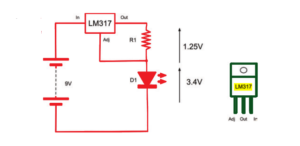
The LM317 is very easy to use in a constant current mode. It will always strive to keep its output voltage at exactly 1.25V above whatever voltage the Adj (adjust) pin is at.
The LED we are going to use is a 1W white light LED. It has an If (forward current) of 300mA and a Vf (forward voltage) of 3.4V.
The formula for calculating the right value for R for use with the LM317 is:
A half-watt resistor will, therefore, be fine.
The LM317 also needs its input to be about 3V higher than its output to guarantee 1.25V between Adj and the output.
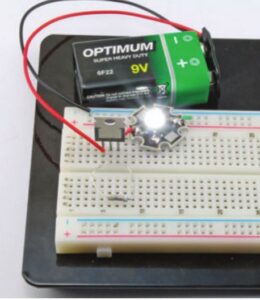 This means that a 6V battery would not be quite high enough because the forward voltage is 3.4V. However, we could drive the circuit using a 9V battery or even a 12V power supply without modification, since whatever the input voltage, the current will always be limited to about 260mA.
This means that a 6V battery would not be quite high enough because the forward voltage is 3.4V. However, we could drive the circuit using a 9V battery or even a 12V power supply without modification, since whatever the input voltage, the current will always be limited to about 260mA.
A quick calculation of the power consumed by the LM317 will reassure us that we are not going to come near exceeding its maximum power rating.
For a 9V battery, the voltage between In and Out will be
9 – (1.25 + 3.4) = 4.35V.
The current is 260mA, so the power is:
4.35 × 0.26 = 1.13W.
According to its datasheet, the maximum power handling capability of the LM317 is 20W, and it can cope with a current of up to 2.2A for a supply voltage of less than 15V. So we are fine.
Related Articles
- Basic Types of Current Transformers
Current Transformers (CT’s) are instrument transformers that are used to supply a reduced value of…
- Types of Electric Current - Steady (DC), Varying & Alternating (AC) Current
The directed flow of free electrons (or charge) is called the electric current. The electric…
- Current Transformers - Windings and Rated Insulation Levels
A current transformer is an instrument transformer in which the current ratio is within the…
- What Are Current, Resistance and Voltage?
Voltage, current, and resistance are three properties that are fundamental to almost everything you will…
- Effect of Electric Current on Human Body at 50 Hz
Each year in France, for example, 200 people die of electrocution and 500 suffer serious…
- Arduino based Automatic Light Controller
The automatic light controller offers energy saving and convenience in the areas with a photosensor…
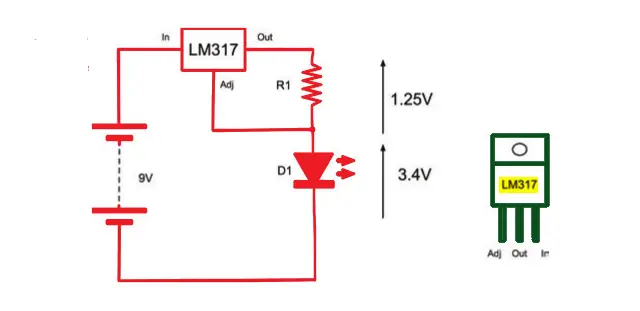
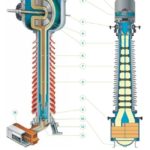
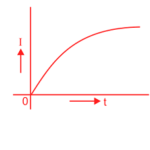
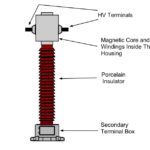
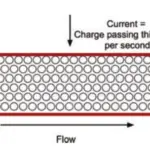

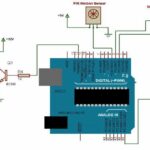

I am going to make it. Thanks for explaining